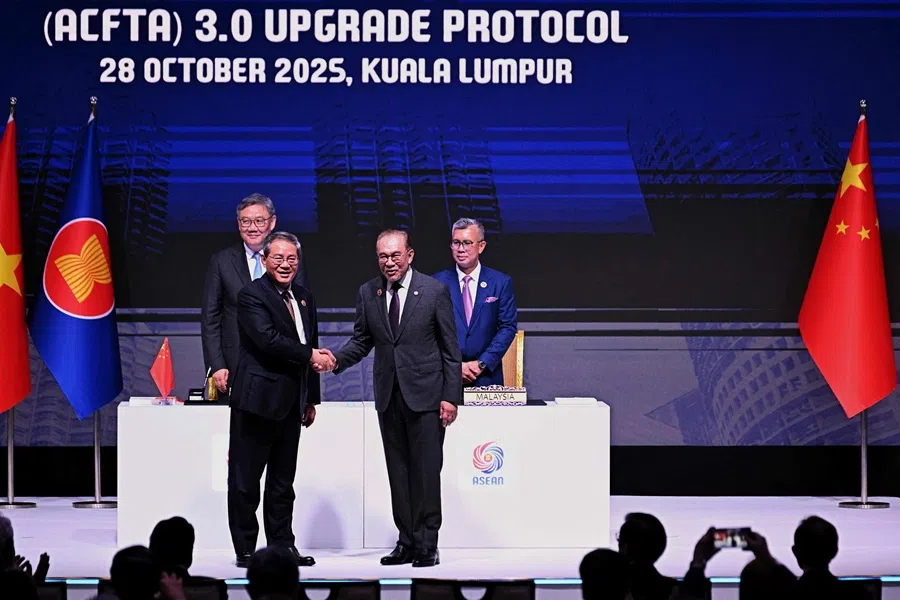ACFTA 3.0: Beijing’s quiet triumph in Southeast Asia
China is quietly weaving a new economic architecture in Southeast Asia through the upgraded ASEAN-China Free Trade Area (ACFTA) 3.0, while US influence languishes in the region. Researcher Ronny P Sasmita argues that this strategic pact reshapes regional influence, by embedding Beijing’s standards and technologies across ASEAN.

When China and ASEAN signed the upgraded ASEAN-China Free Trade Area (ACFTA) 3.0 agreement in Kuala Lumpur, few in Washington noticed. The spotlight instead fell on US President Donald Trump, who stood as a symbolic witness to the peace accord between Cambodia and Thailand. Yet behind that ceremony lay a far more consequential story, one that reveals how China has quietly tightened its hold on Southeast Asia’s economic future while the US drifts towards a narrower role focused on defence and security.
Shaping Asia’s economic future
The ACFTA 3.0 is the most ambitious upgrade of their trade relationship since the pact began over a decade ago. The new version goes far beyond tariff reductions, expanding into the digital economy, green technology, supply chain integration and small-and-medium enterprise cooperation. In essence, it is about designing the future infrastructure of Asia’s economy rather than just trading more goods.
For China, the deal is a lifeline as much as it is an opportunity. Under pressure from renewed US tariffs and protectionist barriers, ACFTA 3.0 opens a vast alternative market of more than 680 million people and a combined GDP of nearly US$4 trillion. It allows Chinese companies to redirect exports, investments and technology into ASEAN, cushioning the blow from trade restrictions in the West. Strategically, it is a shield against American economic coercion disguised as a development partnership.
Through ACFTA 3.0, China embeds itself in ASEAN’s economic architecture and extends its Belt and Road influence into legal and institutional frameworks.
For ASEAN, the benefits are direct and substantial. The agreement simplifies customs procedures, improves market access and strengthens cooperation in innovation and technology transfer. It also encourages investment in renewable energy and digital infrastructure, aligning with ASEAN’s ambition to climb the global value chain. Economies like Vietnam, Indonesia and Malaysia will gain from closer industrial cooperation with China, while Singapore and Thailand are set to attract more technology and logistics investment.
Deepening Chinese integration in ASEAN’s economic framework
But this relationship is far from equal. Through ACFTA 3.0, China embeds itself in ASEAN’s economic architecture and extends its Belt and Road influence into legal and institutional frameworks. The new chapters on digital trade and supply chain connectivity will operate largely on Chinese standards, reinforcing Beijing’s regulatory reach across Southeast Asia. From e-commerce platforms to smart ports and logistics networks, the region’s digital backbone will increasingly reflect Chinese design and capital.

While Washington doubles down on its Indo-Pacific defence posture, China is reshaping the economic reality beneath it. ACFTA 3.0 strengthens Beijing’s hand by turning trade cooperation into strategic alignment. The agreement dilutes the effectiveness of US tariffs and sanctions by giving China new routes for production and distribution through ASEAN. It also transforms the region into a semi-integrated economic zone revolving around Chinese technology, capital and consumer demand.
The timing is no coincidence. Facing a second wave of Trump-era tariff escalation, Beijing needs alternative export corridors and partners immune from US pressure. ASEAN, with its neutrality and proximity, offers exactly that. The region benefits from Chinese investment while China secures access to affordable labour, natural resources, and emerging digital markets. This mutual pragmatism deepens interdependence, and in doing so, it shifts the balance of influence in Asia.
The contrast between America’s symbolic diplomacy and China’s structural power play could not be sharper. While the US celebrated peace between two small neighbours, China secured an economic order that will outlast any single administration. Washington’s presence in Southeast Asia is increasingly limited to security arrangements, military exercises and defence exports. Its economic agenda, once central to regional growth, has been reduced to slogans like the Indo-Pacific Economic Framework that lack tangible incentives.
For the US, the implications are sobering. Its absence from the region’s largest and most advanced trade agreement exposes a shrinking sphere of economic relevance.
China’s structural influence
Meanwhile, ACFTA 3.0 gives China the means to weave economic and technological influence into every corner of the region. Even sectors traditionally associated with Western dominance, such as defence-related manufacturing and advanced technology, are now being touched by Chinese capital under the banner of industrial cooperation. Drones, AI-based logistics and smart surveillance systems are being traded as tools of modernisation, blurring the line between commerce and strategy.
For ASEAN leaders, the choice is practical rather than ideological. Siding with Washington’s economic nationalism risks missing out on growth, while engaging China promises immediate capital and connectivity. The result is a subtle but steady economic alignment towards Beijing, one that may eventually translate into political leverage. ASEAN gains prosperity, but at the cost of deepening dependence on Chinese markets, technology and finance.

For the US, the implications are sobering. Its absence from the region’s largest and most advanced trade agreement exposes a shrinking sphere of economic relevance. The power once exercised through institutions like the Trans-Pacific Partnership has been ceded to China’s expanding network of trade deals. The Indo-Pacific may still rely on American defence, but its economy increasingly speaks Mandarin.
As Trump celebrates symbolic peace, China celebrates structural victory.
ACFTA 3.0 is more than a technical trade update; it is a turning point in the silent contest for Southeast Asia’s future. It shows how China has transformed tariff wars into a catalyst for deeper integration with its neighbours, while the US watches from the sidelines. As Trump celebrates symbolic peace, China celebrates structural victory. In the long run, 28 October might be remembered not for diplomacy in Phnom Penh, but for the day Beijing quietly edged America out of ASEAN’s economic heart.
In other words, ACFTA 3.0 is not just a trade upgrade, it is the blueprint of a new Asian order. It marks China’s shift from a manufacturing giant to a rule-maker, while the US lingers as a guest at a table it once set. The region’s growth corridors now pulse with RMB credit, Chinese platforms and digital systems built to Beijing’s standards. What began as a tactical escape from tariffs has become the economic architecture of a post-America Asia, one where Washington still talks security, but Beijing quietly writes the rules.





